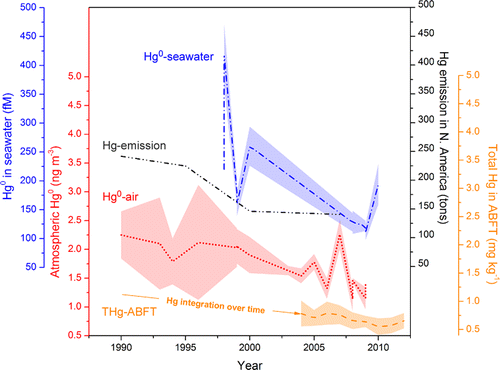Credit: American Chemical Society
For years, public health experts have warned against eating certain kinds of fish, including tuna, that tend to accumulate mercury. Still, tuna consumption provides more mercury to U.S. consumers than any other source. But recently, as industry cuts down on its mercury emissions, research has found mercury concentrations in some fish are dropping. The latest study, published in Environmental Science & Technology, reports that this is the case for prized Atlantic bluefin tuna.
Although global mercury emissions continue to rise due largely to increases in coal burning in Asia, emissions in North America between 1990 and 2007 went down 2.8 percent per year, according to published studies in 2010 and 2013. Over a similar period, mercury in north Atlantic waters dropped 4.3 percent annually. And between 2001 and 2009, mercury in the air above the north Atlantic declined by 20 percent, or about 2.5 percent per year.
To see whether the regional emissions reductions were having an effect on fish at the top of the ocean food chain, researchers from Stony Brook University, the University of Massachusetts and Harvard University collected and analyzed tissue samples from nearly 1,300 Atlantic bluefin tuna captured between 2004 and 2012. Tests for mercury content showed that over this eight-year period, the concentration in the fish dropped an average of 19 percent. The finding suggests that reductions in mercury emissions could rapidly lead to reduced mercury concentrations in some marine fish, the researchers say.
More information: Cheng-Shiuan Lee et al. Declining Mercury Concentrations in Bluefin Tuna Reflect Reduced Emissions to the North Atlantic Ocean, Environmental Science & Technology (2016). DOI: 10.1021/acs.est.6b04328
Abstract
Tunas are apex predators in marine food webs that can accumulate mercury (Hg) to high concentrations and provide more Hg (∼40%) to the U.S population than any other source. We measured Hg concentrations in 1292 Atlantic bluefin tuna (ABFT, Thunnus thynnus) captured in the Northwest Atlantic from 2004 to 2012. ABFT Hg concentrations and variability increased nonlinearly with length, weight, and age, ranging from 0.25 to 3.15 mg kg–1, and declined significantly at a rate of 0.018 ± 0.003 mg kg–1 per year or 19% over an 8-year period from the 1990s to the early 2000s. Notably, this decrease parallels comparably reduced anthropogenic Hg emission rates in North America and North Atlantic atmospheric Hg0 concentrations during this period, suggesting that recent efforts to decrease atmospheric Hg loading have rapidly propagated up marine food webs to a commercially important species. This is the first evidence to suggest that emission reduction efforts have resulted in lower Hg concentrations in large, long-lived fish.
Journal information: Environmental Science & Technology
Provided by American Chemical Society






















